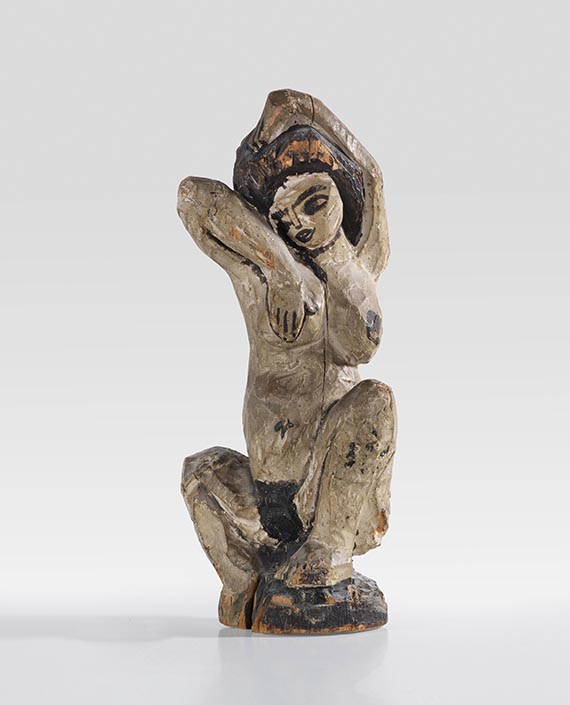Dictionary


Porcelain
Porcelain is a hard-fired ceramic ware made of a particular type of clay. Its essential ingredients are refactory white clay (kaolin, the purest type of china clay), quartz and feldspathic rock. Firing results in a dense, hard, fine-grained and pure white body. The proportions of the ingredients determine whether porcelain is hard-body, that is fired twice (50/25/25), or soft-paste porcelain (25/30/45). The firing temperature of porcelain is higher than that used for other ceramic wares, which makes even relatively thin-walled pieces very durable. Firing shrinks a piece of porcelain to about a third of its original size. Porcelain was also called "white gold" in Germany. colored glazes enhance the porcelain body and making them requires great skill and artifice. In addition to perfect form and purity of body, all makers of porcelain strove for consummate mastery of glaze making. All superior pieces of porcelain bear several types of marks revealing their origin (including factory marks on German porcelain in the form of pictograms and character marks on Chinese porcelain that represent words) on the undersides of vessels and objects. Invented in the T'ang dynasty (618-906 AD) in China, where it was also perfected, porcelain was also later made in Japan to just as high a standard. Porcelain objects did not reach Europe in any quantity until the 17th century (Chinese export porcelain: European imitations of Chinese decoration and figures are known as chinoiserie) - but were soon extremely popular and were much sought after as the most precious collector's items. In the early 18th century, 1708/09, Johann Friedrich Böttger in Dresden finely succeeded in discovering how to make the paste for a "European" porcelain that was as fine as Asian china. The discovery led to the establishment of numerous porcelain manufactories throughout Europe. The most important European porcelain factories in the 17th and 18th centuries are listed below - with the dates of establishment:
1653: Delft
1710: Meissen (Meissen porcelain)
1718: Vienna
1743: Capo di Monte near Naples
1745: Chelsea, London
1745: Vincennes and Sèvres, Paris
1746: Höchst (the Höchst Porcelain Factory)
1747: Fürstenberg
1747: Nymphenburg (the Nymphenburg Porcelain Factory)
1751: Berlin
1755: St Petersburg
1755: Frankenthal (the Palatinate)
1758: Ludwigsburg
1760: Copenhagen
1761: Kelsterbach
1762: Älteste Volkstedter
1763: Zurich
1765: Fulda
1766: Kassel
1777: Ilmenau
1783: Rauenstein (Thuringia)
Porcelain is a hard-fired ceramic ware made of a particular type of clay. Its essential ingredients are refactory white clay (kaolin, the purest type of china clay), quartz and feldspathic rock. Firing results in a dense, hard, fine-grained and pure white body. The proportions of the ingredients determine whether porcelain is hard-body, that is fired twice (50/25/25), or soft-paste porcelain (25/30/45). The firing temperature of porcelain is higher than that used for other ceramic wares, which makes even relatively thin-walled pieces very durable. Firing shrinks a piece of porcelain to about a third of its original size. Porcelain was also called "white gold" in Germany. colored glazes enhance the porcelain body and making them requires great skill and artifice. In addition to perfect form and purity of body, all makers of porcelain strove for consummate mastery of glaze making. All superior pieces of porcelain bear several types of marks revealing their origin (including factory marks on German porcelain in the form of pictograms and character marks on Chinese porcelain that represent words) on the undersides of vessels and objects. Invented in the T'ang dynasty (618-906 AD) in China, where it was also perfected, porcelain was also later made in Japan to just as high a standard. Porcelain objects did not reach Europe in any quantity until the 17th century (Chinese export porcelain: European imitations of Chinese decoration and figures are known as chinoiserie) - but were soon extremely popular and were much sought after as the most precious collector's items. In the early 18th century, 1708/09, Johann Friedrich Böttger in Dresden finely succeeded in discovering how to make the paste for a "European" porcelain that was as fine as Asian china. The discovery led to the establishment of numerous porcelain manufactories throughout Europe. The most important European porcelain factories in the 17th and 18th centuries are listed below - with the dates of establishment:
1653: Delft
1710: Meissen (Meissen porcelain)
1718: Vienna
1743: Capo di Monte near Naples
1745: Chelsea, London
1745: Vincennes and Sèvres, Paris
1746: Höchst (the Höchst Porcelain Factory)
1747: Fürstenberg
1747: Nymphenburg (the Nymphenburg Porcelain Factory)
1751: Berlin
1755: St Petersburg
1755: Frankenthal (the Palatinate)
1758: Ludwigsburg
1760: Copenhagen
1761: Kelsterbach
1762: Älteste Volkstedter
1763: Zurich
1765: Fulda
1766: Kassel
1777: Ilmenau
1783: Rauenstein (Thuringia)
Offers
Headquarters
Joseph-Wild-Str. 18
81829 Munich
Phone: +49 89 55 244-0
Fax: +49 89 55 244-177
info@kettererkunst.de
Louisa von Saucken / Undine Schleifer
Holstenwall 5
20355 Hamburg
Phone: +49 40 37 49 61-0
Fax: +49 40 37 49 61-66
infohamburg@kettererkunst.de
Dr. Simone Wiechers / Nane Schlage
Fasanenstr. 70
10719 Berlin
Phone: +49 30 88 67 53-63
Fax: +49 30 88 67 56-43
infoberlin@kettererkunst.de
Cordula Lichtenberg
Gertrudenstraße 24-28
50667 Cologne
Phone: +49 221 510 908-15
infokoeln@kettererkunst.de
Hessen
Rhineland-Palatinate
Miriam Heß
Phone: +49 62 21 58 80-038
Fax: +49 62 21 58 80-595
infoheidelberg@kettererkunst.de
We will inform you in time.




